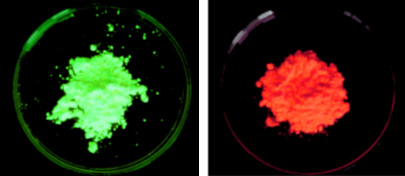Success in Trial Manufacture of White LED for Liquid Crystal Backlight
Improvement in Color Reproduction of Liquid Crystal Displays
2008.03.19
National Institute for Materials Science
Dr. Naoto Hirosaki, Group Leader of the Nitride Particle Group, Nano Ceramics Center of the National Institute for Materials Science succeeded in trial manufacture of a white light emitting diode (LED) which is suitable for backlight applications in liquid crystal displays.
Abstract
- Dr. Naoto Hirosaki, Group Leader of the Nitride Particle Group, Nano Ceramics Center (Managing Director: Yoshio Sakka) of the National Institute for Materials Science (hereinafter, NIMS; President: Prof. Teruo Kishi) succeeded in trial manufacture of a white light emitting diode (LED) which is suitable for backlight applications in liquid crystal displays. Improvements in the color-development properties of the green phosphor (announced in March 2005) and red phosphor (announced in August 2004) developed by NIMS made it possible to offer LEDs comprising the three primary colors of light, red, green, and blue. Because this LED has few components other than the three primary colors, if used in combination with color filters, it is possible to extract the three primary colors with high purity. Thus, this development succeeded in expanding the color reproduction region of liquid crystal displays.
- Liquid crystal displays are devices which display an image by decomposing the white light produced by a backlight into the three primary colors using liquid crystals and color filters, and are used in flat panel televisions, personal computers, cell phones, and other electronic devices. The present backlights are mainly compact fluorescent lamps called cold cathode fluorescent lamps (CCFL), but because CCFL contain mercury, a mercury-free light source is required for environmental reasons. LEDs have the advantages of compact size, light weight, and low power consumption, and do not use mercury, and therefore are expected to replace CCFLs in the future. However, the existing LEDs emit light which is a mixture of blue and yellow light, resulting in an unnatural light that lacks the colors green and red. For this reason, they are not suitable for use as a backlight source, which requires the three primary colors. Thus, realization of a dedicated LED for backlights, which possesses good color reproducibility, had been desired.
- The developed LED light source comprises a blue LED chip, a CaAlSiN3 red phosphor, and a β sialon green phosphor. By adopting a composition which includes the three primary colors, it is possible to obtain red, green, and blue with good color purity by using the new LED in combination with liquid crystals and color filters. According to the results of a simulation, the NTSC ratio, of 91% was achieved (the NTSC ratio is an index of the color reproducibility of displays), indicating success in the trail manufacture of a light source with a wide range of color reproducibility.
- These research results are scheduled to be presented at the 55th Meeting of The Japan Society of Applied Physics and Related Societies, to be held at the Funabashi Campus of the Nihon University School of Science and Technology in Funabashi City, Chiba Prefecture beginning March 27.

Fig.:β sialon green light phosphor and CaAlSiN3 red light phosphor
